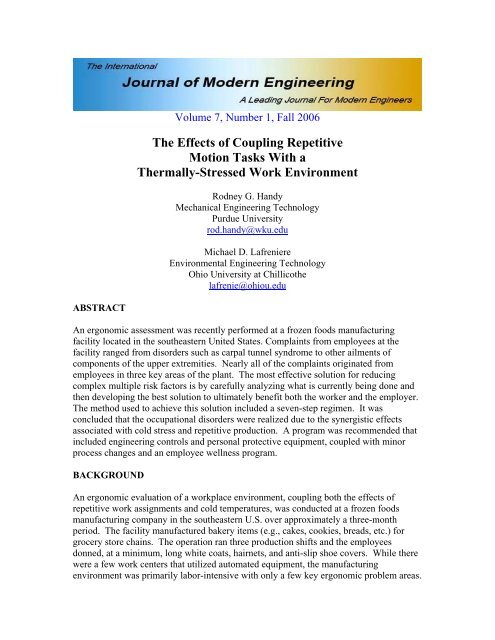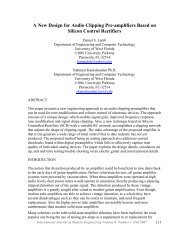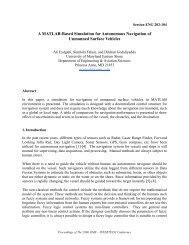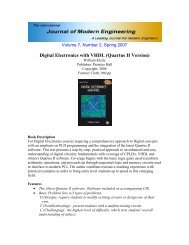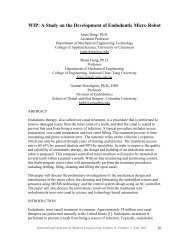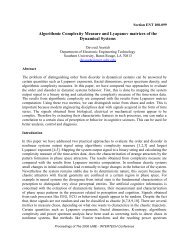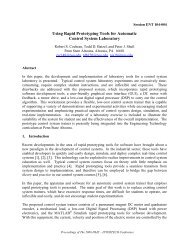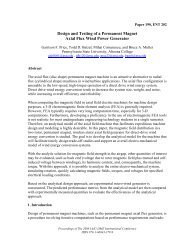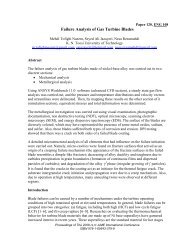The Effects of Coupling Repetitive Motion Tasks With a ... - IJME
The Effects of Coupling Repetitive Motion Tasks With a ... - IJME
The Effects of Coupling Repetitive Motion Tasks With a ... - IJME
You also want an ePaper? Increase the reach of your titles
YUMPU automatically turns print PDFs into web optimized ePapers that Google loves.
Volume 7, Number 1, Fall 2006<br />
<strong>The</strong> <strong>Effects</strong> <strong>of</strong> <strong>Coupling</strong> <strong>Repetitive</strong><br />
<strong>Motion</strong> <strong>Tasks</strong> <strong>With</strong> a<br />
<strong>The</strong>rmally-Stressed Work Environment<br />
Rodney G. Handy<br />
Mechanical Engineering Technology<br />
Purdue University<br />
rod.handy@wku.edu<br />
Michael D. Lafreniere<br />
Environmental Engineering Technology<br />
Ohio University at Chillicothe<br />
lafrenie@ohiou.edu<br />
ABSTRACT<br />
An ergonomic assessment was recently performed at a frozen foods manufacturing<br />
facility located in the southeastern United States. Complaints from employees at the<br />
facility ranged from disorders such as carpal tunnel syndrome to other ailments <strong>of</strong><br />
components <strong>of</strong> the upper extremities. Nearly all <strong>of</strong> the complaints originated from<br />
employees in three key areas <strong>of</strong> the plant. <strong>The</strong> most effective solution for reducing<br />
complex multiple risk factors is by carefully analyzing what is currently being done and<br />
then developing the best solution to ultimately benefit both the worker and the employer.<br />
<strong>The</strong> method used to achieve this solution included a seven-step regimen. It was<br />
concluded that the occupational disorders were realized due to the synergistic effects<br />
associated with cold stress and repetitive production. A program was recommended that<br />
included engineering controls and personal protective equipment, coupled with minor<br />
process changes and an employee wellness program.<br />
BACKGROUND<br />
An ergonomic evaluation <strong>of</strong> a workplace environment, coupling both the effects <strong>of</strong><br />
repetitive work assignments and cold temperatures, was conducted at a frozen foods<br />
manufacturing company in the southeastern U.S. over approximately a three-month<br />
period. <strong>The</strong> facility manufactured bakery items (e.g., cakes, cookies, breads, etc.) for<br />
grocery store chains. <strong>The</strong> operation ran three production shifts and the employees<br />
donned, at a minimum, long white coats, hairnets, and anti-slip shoe covers. While there<br />
were a few work centers that utilized automated equipment, the manufacturing<br />
environment was primarily labor-intensive with only a few key ergonomic problem areas.
<strong>The</strong> key areas <strong>of</strong> the assessment were designated at the onset as Cake Icing, Frozen<br />
Packaging, and Cake Packaging. Cake Packaging and Cake Icing were kept at a nominal<br />
temperature <strong>of</strong> 65 degrees F throughout the year, while the normal temperature in Frozen<br />
Packaging was approximately 45 degrees F. Nearly all <strong>of</strong> the past complaints <strong>of</strong><br />
ergonomic disorders at this facility came from these three areas. Other than the extreme<br />
temperatures and the existence <strong>of</strong> relatively repetitive job tasks, these work areas were<br />
otherwise typical <strong>of</strong> the other production areas at this site. From the review <strong>of</strong> past<br />
complaints that had been documented, most <strong>of</strong> the disorders had been carpal tunnel<br />
syndrome or similar ailments <strong>of</strong> the wrist or other components <strong>of</strong> the upper extremity<br />
(e.g., fingers, hand, arm, elbow, etc.).<br />
<strong>The</strong> increase in concerns for ergonomic issues in the workplace is well founded.<br />
According to the Bureau <strong>of</strong> Labor Statistics, more than 50% <strong>of</strong> all occupational illnesses<br />
reported in 1997 were associated with repetitive motion trauma. A repetitive motion<br />
injury is not an acute or short-term result <strong>of</strong> a one-time accident, but instead, the chronic<br />
result <strong>of</strong> gradual, repeated trauma. <strong>The</strong> three most common repetitive motion injuries are<br />
muscle, tendon, and nerve injuries.[ 1,2 ] In manufacturing environments resembling the<br />
one in this study, carpal tunnel syndrome is by far the most common form <strong>of</strong> repetitive<br />
trauma disorder.<br />
Carpal tunnel syndrome (CTS) is the term used to describe the set <strong>of</strong> symptoms that<br />
result when the median nerve in the wrist is damaged or compressed.[ 2 ] <strong>The</strong> symptoms<br />
<strong>of</strong> CTS range from mild numbness or faint tingling to extreme pain and/or loss <strong>of</strong> the use<br />
<strong>of</strong> the thumb.[ 3 ] <strong>The</strong> most typical job activities that lead to this disorder are repetitive<br />
operations <strong>of</strong> 30 seconds per cycle or less.[ 2 ] CTS has shown up in studies <strong>of</strong> workers in<br />
frozen food plants, pork processing plants, and among supermarket workers.[ 4-7 ] By the<br />
inherent nature, light manufacturing operations such as buffing, grinding, cutting, and<br />
packing (as well as cake icing and pressing) could all result in prevalence <strong>of</strong> CTS cases.<br />
Other repetitive motion injuries <strong>of</strong> the upper extremity that could be related to the laborintensive<br />
operations at this facility are deQuervain’s syndrome (a thumb ailment resulting<br />
from forceful gripping or twisting) and tendonitis (the inflammation <strong>of</strong> the tendon<br />
resulting from repeated tension, motion, or bending in contact with a hard surface).<br />
An added stress to the occupational environment <strong>of</strong> this study was the cold temperatures.<br />
Chronic exposures to low temperatures in workplace can contribute to such problems as<br />
numbness, diminished sensory feedback, and decreased flow <strong>of</strong> blood [ 8 ]. When this<br />
occurs, many times workers will try to compensate by increasing the force <strong>of</strong> their grip<br />
on either the tool or the part. This can lead to exerting unnecessary strain on the upper<br />
extremities and possible injury.[ 1,3,9 ] It is recommended that gloves be worn when<br />
environmental air is less than 20 degrees C for a prolonged period <strong>of</strong> time[ 1,10,11 ]. In<br />
addition, under cold-stressed conditions it is recommended that the worker be provided<br />
rubber or plastic handled tools to add insulation to the stress relief benefit.[ 2 ] However,<br />
both s<strong>of</strong>ter tools and glove wearing may cause a more forceful grip, thus causing more<br />
stress on the hands and wrist. As evidence, it has been found that gloves can reduce<br />
strength as much as 30% and delay task completion by up to 37%.[ 12-15 ]
Ergonomic problems like those realized in this study were most likely explained by the<br />
premise that the exposures are a part <strong>of</strong> a complex multiple risk factor function. It could<br />
be that the surfacing <strong>of</strong> the problem was likely due to the combination <strong>of</strong> synergistic<br />
effects resulting from the existence <strong>of</strong> repetitive tasks under both cold and humid<br />
conditions. For multiple risk exposures, the most effective solution is to reduce risk<br />
factors by carefully analyzing what was currently being done, and then come up with the<br />
best solution to ultimately benefit both the worker and the company[ 16,17 ]. <strong>The</strong> following<br />
methods were devised to best serve this objective.<br />
METHODS<br />
Since no applicable occupational exposure limits (OELs) currently exist for ergonomics<br />
or cold environments, the methods developed were mainly qualitative. <strong>The</strong> following<br />
methods, in chronological order, were used to evaluate ergonomics in the three<br />
production areas <strong>of</strong> concern:<br />
1. Walkthrough with interview <strong>of</strong> safety staff.<br />
2. Research <strong>of</strong> the literature.<br />
3. Interview with effected employees.<br />
4. Development and completion <strong>of</strong> qualitative ergonomics worksheets.<br />
5. Videotaping <strong>of</strong> appropriate jobs.<br />
6. Measurement <strong>of</strong> temperature and humidity conditions.<br />
7. Evaluation <strong>of</strong> personal protective clothing (PPC).<br />
Walkthrough:<br />
<strong>The</strong> original walkthrough <strong>of</strong> the facility was conducted early on in the evaluation. It was<br />
used to primarily characterize the job functions and constraints <strong>of</strong> the workers. In<br />
addition, it aided in the familiarization <strong>of</strong> the various processes and work centers<br />
involved. <strong>The</strong> safety staff <strong>of</strong> the facility accompanied the researchers on the walkthrough<br />
and provided a history <strong>of</strong> the problem and identified the problematic areas.<br />
Literature Review:<br />
Subsequently, an effort was made to identify comparable studies that had been performed<br />
by other researchers. An EH&S database was utilized to research comparable studies<br />
written in the literature. While the research found was not extensive on ergonomic issues<br />
couple with thermally-stressed environments, the studies that were located aided in the<br />
recognition <strong>of</strong> potential ergonomic problems. <strong>The</strong> literature review began at the onset <strong>of</strong><br />
the study and continued throughout the duration <strong>of</strong> the assessment.<br />
Interviews:<br />
Interviews were completed with 12 affected employees during the second and third week<br />
<strong>of</strong> the project. A representative sample was taken from each <strong>of</strong> the three high-risk areas<br />
<strong>of</strong> the facility. Arguably, the best source to learn about a process or a workstation is the<br />
operator(s). While it appeared to have some bias, the information gathered from the<br />
operators on individual worker history and questionable facility processes was
noteworthy and credible. Each worker was interviewed for approximately ten minutes.<br />
While the same exact questions were not asked <strong>of</strong> each employee, they were very similar<br />
in theme and scope. Specifically, the employees were anonymously asked questions that<br />
focused on the root <strong>of</strong> the ergonomic problems at hand.<br />
Qualitative Worksheets:<br />
Ergonomic worksheets were used to prioritize problem areas. Three different types <strong>of</strong><br />
worksheets were used to assist in the preparation <strong>of</strong> an ergonomic job analysis. <strong>The</strong>se<br />
worksheets were variations on field-acceptable worksheets used by ergonomic<br />
consultants and industry. Factors such as job effort levels, priorities for change, stress,<br />
posture, force, repetitiveness, etc. were subjectively evaluated and given a number<br />
ranking or a yes/no response.<br />
Videotaping Jobs for Analysis:<br />
Videotaping <strong>of</strong> the problem areas in Cake Icing, Frozen Production Packaging, and Cake<br />
Packaging was performed over a two-week period. <strong>The</strong> workers at each workstation in<br />
these areas were filmed for approximately two minutes each, respectively. <strong>The</strong> film was<br />
viewed several times for accuracy and consistency <strong>of</strong> microanalyses and subsequent<br />
ergonomic assessments. Factors such as repetitive body motions, distance from worker<br />
to part, part height and movement, and apparent worker comfort were carefully<br />
evaluated.<br />
Temperature and Humidity Characterization:<br />
An indoor air quality monitor was used to measure the temperature and humidity in the<br />
areas <strong>of</strong> concern. Special attention was given to fluctuations during the course <strong>of</strong> the<br />
surveys. Temperature and humidity were measured continuously in each <strong>of</strong> the areas for<br />
approximately one hour. Also, employees were asked during this time period whether or<br />
not they believed that there was ever any significant temperature variability from shift-toshift<br />
or from day-to-day.<br />
Evaluation <strong>of</strong> Personal Protective Clothing (PPC):<br />
<strong>The</strong> evaluation <strong>of</strong> PPC was focused on determining the type <strong>of</strong> hand and wrist protection<br />
that should be donned while performing specific jobs in the three problem areas. <strong>The</strong><br />
technique used to make this evaluation was a qualitative survey sheet. Approximately six<br />
weeks into the assessment, five affected employees evaluated three types <strong>of</strong> protective<br />
gloves (the current porous cotton, cotton, and synthetic) for suitability. After wearing the<br />
three types <strong>of</strong> glove materials for one hour, the employees were asked to give a score <strong>of</strong> 1<br />
to 5, with 1 being poor and 5 being excellent, on four merit criteria: thermal comfort,<br />
physical comfort, durability, and applicability. <strong>The</strong> one-hour sampling times were backto-back<br />
in order to cut down on bias. A composite score was determined for the survey<br />
and then compared with cost for the final determination <strong>of</strong> the appropriate PPC.<br />
RESULTS<br />
<strong>The</strong> employee interviews brought out several key points. Most <strong>of</strong> the employee<br />
complaints were related to the soreness <strong>of</strong> the wrist and hand. A few complaints were
directed at soreness in the elbow and shoulder areas. In addition, several complained <strong>of</strong><br />
palletizing and stacking, which seemed to either cause or complicate existing back pain.<br />
<strong>The</strong> employees in all three areas noted that the temperature <strong>of</strong> their work environment<br />
fluctuated, with most <strong>of</strong> the fluctuation being in Cake Icing and Cake Packaging. <strong>The</strong><br />
workers pointed out that the main factors that caused the temperature fluctuations were<br />
seasonal variations and the opening/closing <strong>of</strong> doors. In addition, it was observed that the<br />
employees rotated jobs relatively <strong>of</strong>ten and usually after about one hour. However, many<br />
times this rotation involved the movement to a very comparable job with similar<br />
repetitive hand/wrist action. Of the twelve employees interviewed, only one mentioned<br />
<strong>of</strong> having any problems with the tools currently used.<br />
<strong>The</strong> qualitative worksheets were used to help identify the major problem workstations<br />
within each <strong>of</strong> the three work areas. Careful evaluation <strong>of</strong> the completed worksheet<br />
resulted in the identification <strong>of</strong> the Bread Packaging and Cooking Packaging occupations<br />
in Frozen Packaging as the most ergonomically unsound. Other high-risk jobs identified<br />
included cake icing stations located in Cake Icing and the two packing positions in Cake<br />
Packaging. <strong>The</strong> distance and height <strong>of</strong> the work piece to the employee in these high-risk<br />
areas were within the guideline values for these jobs. However, there was evidence <strong>of</strong><br />
excessive bending <strong>of</strong> the wrist(s). It should be noted that the workers observed were<br />
given the option <strong>of</strong> whether or not they wear gloves in Cake Icing while the observed<br />
employees in Cake Packaging and Frozen Packaging all wore some type <strong>of</strong> glove<br />
protection. All <strong>of</strong> these jobs have a repetitive sequence to complete in just a few seconds<br />
duration. No vibrating tools were observed and chairs/stools were provided at less than<br />
one-half <strong>of</strong> the workstations.<br />
<strong>The</strong> viewing <strong>of</strong> the videotape <strong>of</strong> the high-risk jobs provided some useful information,<br />
primarily regarding the seriousness <strong>of</strong> each <strong>of</strong> the high-risk jobs. While viewing the<br />
cookie packing operation in Frozen Packaging, it became evident <strong>of</strong> the amount <strong>of</strong> up and<br />
down, upper-body flexing that was occurring during the course <strong>of</strong> just one cycle.<br />
Because <strong>of</strong> the complexity <strong>of</strong> the repetitive motion, coupled with a robust production rate<br />
and cold working conditions, it was determined that this workstation was the most<br />
ergonomically at-risk for repetitive trauma disorders (RTDs). <strong>The</strong> videotape viewing<br />
also provided other results as follows:<br />
1. <strong>The</strong> production rate during the bread packaging operation was too fast.<br />
2. <strong>The</strong>re was too much distance between the operator and the conveyor at the<br />
cake packaging station.<br />
3. In Cake Packaging and Cake Icing, the employees rotated back and forth<br />
between wearing gloves and not wearing gloves. In addition, they wore<br />
different configurations <strong>of</strong> PPC on their hands and wrists.<br />
4. <strong>The</strong>re were uncomfortable postures observed at the cake stacking position,<br />
resulting in leaning.<br />
5. In Cake Icing the side scrape tool and the top scrape tool had design<br />
inadequacies. Also, there appeared to be a size factor problem with the cotton<br />
glove used to press the cakes together.
<strong>The</strong> result <strong>of</strong> the air quality study showed temperature fluctuations <strong>of</strong> up to six degrees<br />
over just a few hours as well as humidity levels as high as 82%. Interviews with<br />
employees revealed that fluctuations <strong>of</strong> up to ten degrees occur commonly over just a few<br />
hour time duration. Employees complained <strong>of</strong> the dampness <strong>of</strong> the areas, especially<br />
during certain times <strong>of</strong> the year.<br />
<strong>The</strong> PPC/glove assessment provided information on the appropriateness and comfort <strong>of</strong><br />
the different levels <strong>of</strong> hand/wrist protection in cold environments. <strong>The</strong> alternative<br />
<strong>The</strong>rmostat R glove liner was given an average rating <strong>of</strong> “outstanding” (4.8 on a scale <strong>of</strong> 1<br />
to 5) while the other alternative (cotton) and the current glove (porous cotton) were rated<br />
as “acceptable but not optimal” at approximately 3.0 on the same scale. <strong>The</strong> employees<br />
were impressed with the <strong>The</strong>rmostat R glove primarily by its thermal comfort and apparent<br />
durability. As a note, several <strong>of</strong> the employees liked the glove so much that they would<br />
not give it up at the conclusion <strong>of</strong> the test. <strong>The</strong> only problem expressed about the<br />
<strong>The</strong>rmostat R alternative was in Cake Packaging. Employees had a concern about the<br />
applicability <strong>of</strong> the gloves in the packing <strong>of</strong> the cakes. It was noted that the glove was<br />
“slick” on the surface <strong>of</strong> the box. However, upon observation, it did not appear that the<br />
employees were appreciably slowed down by this situation.<br />
RECOMMENDATIONS AND CONCLUSIONS<br />
<strong>The</strong> following was a list <strong>of</strong> the recommendations determined from the ergonomics<br />
assessment <strong>of</strong> this facility. <strong>The</strong> recommendations included:<br />
1. Efforts needed to be focused on reducing the humidity levels in the climatecontrolled<br />
areas. Humidity levels that exceed 60% are considered to be<br />
beyond the level <strong>of</strong> comfort for workers. <strong>The</strong>se levels, coupled with the cold<br />
environment, can complicate RTD conditions and result in a synergistic effect.<br />
Further, the recommendation was to have an evaluation conducted on the<br />
existing HVAC and cooling systems. Also, the installation <strong>of</strong><br />
dehumidification equipment can help to alleviate this problem.<br />
2. Temperature fluctuations should be controlled. Workers have shown stress<br />
when temperature deviations exceed 4 degrees C during the course <strong>of</strong> their<br />
work shifts [ 18 ]. Slow acclimation to extreme temperatures that do not<br />
fluctuate much from the mean will help to minimize conditions resulting from<br />
repetitive motions. In essence, if the process temperature required is 45<br />
degrees F, keep it within a degree or two <strong>of</strong> 45 degrees F during the course <strong>of</strong><br />
the production shift as well as throughout the work year. <strong>The</strong><br />
recommendation was also to keep the doors closed as <strong>of</strong>ten as possible, with<br />
minimal door opening. Further, it was recommended that, during seasonal<br />
changes in the temperature, evaluations should be made to eliminate major<br />
fluctuations in temperature. <strong>The</strong> possible installation <strong>of</strong> a modern<br />
environmental control system should be evaluated on cost and benefit merits.<br />
3. A glove similar to the <strong>The</strong>rmostat R synthetic liner should be adopted as<br />
required PPC for those high-risk operations in Cake Icing, Cake Packaging,<br />
and Frozen Packaging. At a minimum, these workstations should include the
ead and cookie packing occupations in Frozen Packaging, the cake icing and<br />
cake pressing jobs in Cake Icing, and the cake packing stations in Cake<br />
Packaging. <strong>The</strong> liner should be worn in combination with the current outer<br />
gloves in each <strong>of</strong> these areas, respectively.<br />
4. <strong>The</strong> distance to the work piece should be kept at a minimum so that the arm<br />
movements or extensions <strong>of</strong> more than 15 inches are minimized [ 2 ]. While the<br />
workstations that violated this principle in these three areas <strong>of</strong> concern were<br />
only few in numbers, it was noticed that the distance from the operator to the<br />
work piece on the conveyor lines was causing some posture issues. Further,<br />
the recommendation was to place padding on the conveyor structure for the<br />
times when leaning was necessary. Another possible option presented was the<br />
availability <strong>of</strong> an adjustable stool at the various operations. Stool height<br />
issues were particularly noticed during the evaluation <strong>of</strong> the cake stacking<br />
operation.<br />
5. An employee wellness program should be implemented that included<br />
finger/hand exercises aimed at alleviating conditions that lead to RTDs, and in<br />
particular, carpal tunnel syndrome. Simple stretching exercises should be<br />
performed before the shift begins (or during the first 5-10 minutes <strong>of</strong> each<br />
shift) and after the lunch break. This would help to improve the overall body<br />
circulation and aid in the warming up <strong>of</strong> the muscles. A regime recommended<br />
by the American Physical <strong>The</strong>rapy Association would be as follows:<br />
a. Resting one forearm on a table, grasp the fingertips <strong>of</strong> that hand and pull<br />
back gently. Hold this position for five seconds, and then repeat the<br />
exercise with the other hand.<br />
b. Press the palms flat on the table, as if doing a push-up. Lean forward to<br />
stretch the forearm muscles and the wrists.<br />
c. Move the hands around in a circle for about two minutes, thoroughly<br />
stretching the muscles <strong>of</strong> the hand. This helps to restore circulation and<br />
improve the posture <strong>of</strong> the wrist.<br />
d. Finish up by placing a rubber band around the fingers to provide<br />
resistance, and opening and closing the fingers. Do a set <strong>of</strong> ten repetitions<br />
with each hand. Repeat the ten repetitions again at lunchtime and at the<br />
end <strong>of</strong> the shift. In addition to performing the above wellness routine, it<br />
was recommended that the employee should shake out their hands<br />
periodically throughout the day during breaks in production, job rotation,<br />
etc.<br />
6. For the conditions, it appeared that the production rate for bread packaging<br />
was too fast. It was recommended that a qualified industrial engineer or time<br />
study expert conduct a time motion study at this workstation.<br />
7. <strong>The</strong> production boxes should be stacked one less high on the pallets. This was<br />
the only lifting-related concern in the evaluated areas.<br />
8. While there were not major lifting concerns in the three areas evaluated, it was<br />
observed that several <strong>of</strong> the jobs in the main production area have lifting tasks.<br />
It was recommended that these jobs be quantitatively assessed with the<br />
application <strong>of</strong> the OSHA lift equation.
9. An ergonomics awareness program should be implemented plant-wide. This<br />
program would provide training on ergonomic-related issues and be the<br />
vehicle to move the wellness program in the right direction.<br />
10. Employees should be given the option <strong>of</strong> whether or not to sit or stand at most<br />
<strong>of</strong> the evaluated workstations. Experts agree that, in most cases, a physically<br />
comfortable employee will exhibit less overall body stresses, with the<br />
outcome being normally the existence <strong>of</strong> less ergonomically-related<br />
complaints[ 2 ]. However, it was noted that in some situations the process<br />
dictates the need for the employee to stand in order to complete the job task.<br />
11. During the rotation cycle, the supervisors should make every effort to move<br />
employees into positions that have very different body movements than those<br />
<strong>of</strong> the previous one or two rotations.<br />
In conclusion, the synergistic effects associated with the repetitive motions in cold and<br />
humid work environments can lead to premature development <strong>of</strong> occupational disorders<br />
such as CTS. However, the implementation <strong>of</strong> appropriate engineering controls and<br />
personal protective equipment, coupled with additional minor process changes and an<br />
employee wellness program, can help to alleviate the seriousness <strong>of</strong> such work-related<br />
conditions.<br />
As evidence <strong>of</strong> success, prior to the on-set <strong>of</strong> this study, this manufacturing facility had<br />
six individuals with some degree <strong>of</strong> disability attributed to repetitive trauma. Since the<br />
implementation <strong>of</strong> the program, only one additional individual has been diagnosed by an<br />
occupational physician with a disorder in this area. While the corrective action program<br />
initiated from the results <strong>of</strong> this project cannot be considered as the only reason for these<br />
improvements, one would tend to believe that, at a minimum, the impact has been<br />
beneficial.<br />
Companies, such as the one in this study, are realizing productivity benefits in<br />
implementing effective ergonomics programs. It could be easily argued that an<br />
awareness <strong>of</strong> the ergonomic conditions <strong>of</strong> each workstation should become a part <strong>of</strong> the<br />
mindset <strong>of</strong> an operation from the top down. <strong>The</strong> existence <strong>of</strong> this mindset (and<br />
subsequent infrastructure) ultimately could provide the foundation for a successful<br />
ergonomics program and an optimal level <strong>of</strong> worker job satisfaction in many workplace<br />
settings.<br />
REFERENCES<br />
[1] MacLeod D. 2000. <strong>The</strong> Rules <strong>of</strong> Work. New York: Taylor & Francis.<br />
[2] American Industrial Hygiene Association (AIHA). 2003. <strong>The</strong> Occupational<br />
Environment: Its Evaluation and Control. Fairfax, VA: AIHA Press.<br />
[3] Canadian Center for Occupational Health and Safety (CCOHS). 2001. Office<br />
Ergonomics. 3 rd Ed. Hamilton, Ontario: CCOHS.
[4] Chaing HY et al. 1993. Prevalence <strong>of</strong> shoulder and upper-limb disorders among<br />
workers in the fish-processing industry. Scandinavian Journal <strong>of</strong> Work, Environment &<br />
Health, 19(2):126-131.<br />
[5] Fairris D, Brenner M. 2001. Workplace transformation and the rise in cumulative<br />
trauma disorders:Is there a connection? Journal <strong>of</strong> Labor Research, 22(1):15-28.<br />
[6] Moore JS, Garg A. 1991. Determination <strong>of</strong> the operational characteristics <strong>of</strong><br />
ergonomic exposure assessments for prediction <strong>of</strong> disorders <strong>of</strong> the upper extremities and<br />
back. In Proceedings <strong>of</strong> the 11 th Congress <strong>of</strong> the International Ergonomics Association.<br />
London: Taylor & Francis. p 144-146.<br />
[7] Osorio AM, et al. 1994. Carpal tunnel syndrome among grocery store workers.<br />
American Journal <strong>of</strong> Industrial Medicine, 19(2):229-245.<br />
[8] Shiefer RE, et al. 1984. Finger skin temperature and manual dexterity and some intergroup<br />
differences. Applied Ergonomics. 15(2):135-141.<br />
[9] Zakaria D. 2002. Work-related cumulative trauma disorders <strong>of</strong> the upper extremity:<br />
Navigating the epidemiologic literature. American Journal <strong>of</strong> Industrial Medicine, 42(3):<br />
258-269.<br />
[10] Fox WF. 1967. Human performance in the cold. Human Factors, 9(3):203-220.<br />
[11] Pelmear PL, et al. 1986. Hand-arm vibration syndrome in foundry men and hard<br />
rock miners. Journal <strong>of</strong> Low Frequency Noise Vibration, 5(4):163-167.<br />
[12] Hertzberg HT. 1995. Some contributions <strong>of</strong> applied physical anthropology to human<br />
engineering. Annals <strong>of</strong> New York Academy <strong>of</strong> Sciences, 63:616-629.<br />
[13] Lyman J. 1957. 1957. <strong>The</strong> effects <strong>of</strong> equipment design on manual performance in<br />
protection and functioning <strong>of</strong> the hands in cold climates. In Fisher RR, ed. Production<br />
and functioning <strong>of</strong> the hands in cold climates. Washington, DC: National Research<br />
Council. p 86-101.<br />
[14] Plummer RT, et al. 1985. Manual dexterity evaluation <strong>of</strong> gloves used in handling<br />
hazardous materials. In Proceedings <strong>of</strong> the Human Factors Society 29 th Meeting. Santa<br />
Monica, CA: Human Factors Society. p 819-823.<br />
[15] Sperling LR, et al. 1991. Tools and hand function: the cube model-a method for<br />
analysis <strong>of</strong> the handling <strong>of</strong> tools. In Queinnec Y, Daniellou F, eds. Designing for<br />
everyone. London: Taylor & Francis. p 176-178.
[16] Brenner MD et al. 2004. Flexible work practices and occupational safety and health:<br />
exploring the relationship between cumulative trauma disorders and workplace<br />
transformation. Industrial Relations, 43(1): 242-249.<br />
[17] National Institute <strong>of</strong> Occupational Safety and Health (NIOSH). 1997.<br />
Musculoskeletal Disorders in the Workplace. Cincinnati, OH: Dept. <strong>of</strong> Health and<br />
Human Services.<br />
[18] Handy RG, Lafreniere MD. 1999. An automated monitoring system for indoor air<br />
quality. In Proceedings <strong>of</strong> 1 st NSF International Conference on IAQ. Ann Arbor: NSF<br />
International. p 204-210.<br />
BIOGRAPHIES<br />
ROD HANDY is an Associate Pr<strong>of</strong>essor <strong>of</strong> Mechanical Engineering Technology at<br />
Purdue University in West Lafayette, Indiana. He joined the faculty in August <strong>of</strong> 2004.<br />
He earned is B.S. degree from Purdue University in 1983, a MBA from Ball State<br />
University in 1989, and a Ph.D. from the University <strong>of</strong> Florida in 1995. Dr. Handy<br />
teaches courses in manufacturing processes and indoor air quality. His research interests<br />
are in green manufacturing and industrial hygiene sampling.<br />
MICHAEL D. LAFRENIERE is the Associate Dean <strong>of</strong> the Chillicothe campus <strong>of</strong> Ohio<br />
University and the head <strong>of</strong> the Environmental Engineering Technology program at the<br />
location. He has B.S. and M.S.E. degrees from the University <strong>of</strong> Florida and has held<br />
various positions at this campus since 1994. His research interests are in environmental<br />
sampling and hazardous waste management.


